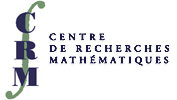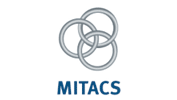 |
|
||||
Org: Niky Kamran (McGill), Oscar Palmas (UNAM) and Adolfo Sanchez Valenzuela (CIMAT)
[PDF]
- BENOIT CHARBONNEAU, Duke University, Durham, NC, USA
Singular monopoles on the product of a circle and a surface [PDF] -
In this talk, I will discuss work done with Jacques Hurtubise (McGill) to relate singular solutions to the Bogomolny equation on a circle times a surface to pairs [holomorphic bundle, meromorphic endomorphism] on the surface. The endomorphism is meromorphic, generically bijective, and corresponds to a return map. Its poles and zeros are related to the singularities of the corresponding solution to the Bogomolny equation.
This talk is based on arXiv:0812.0221.
- ALBERT CHAU, University of British Columbia
Lagrangian mean curvature flow for entire Lipschitz graphs [PDF] -
In this joint work with Jingyi Chen and Weiyong He, we prove existence of longtime smooth solutions to mean curvature flow of entire Lipschitz Lagrangian graphs. We also obtain results on entire translating and self-expanding solutions to the Lagrangian mean curvature flow.
- AILANA FRASER, University of British Columbia
Minimal surfaces, conformal geometry, and the Dirichlet-to-Neumann map [PDF] -
I will talk about joint work with R. Schoen on sharp eigenvalue bounds and minimal surfaces.
- GABRIEL RUIZ HERNANDEZ, CIMAT, Jalisco s.n. Col. Valenciana, Guanajuato, Gto
Higher codimensional Euclidean helix submanifolds [PDF] -
A submanifold of Rn whose tangent space makes constant angle with a fixed direction d is called a helix. Helix submanifolds are related with the Eikonal PDE equation. We will recall a method to find every solution to the Eikonal PDE on any Riemannian manifold, locally. As a consequence we give a local construction of arbitrary Euclidean helix submanifolds of any dimension and codimension. Also we characterize the ruled helix submanifolds and in particular we describe those which are minimal. Some motivations for the study of helix submanifolds comes from the physics of interfaces of liquid cristals. Part of these ideas have a natural extension when the ambient is a Riemannian manifold that admits a parallel vector field.
The next work was done in collaboration with Antonio Di Scala.
- TOM IVEY, College of Charleston, Charleston, SC, United States
Cable knot solutions of the vortex filament flow [PDF] -
A naïve model of vortex filament motion in an ideal fluid leads to an integrable geometric evolution equation for curves in Euclidean 3-space known as the vortex filament flow (VFF). Solutions of the flow are related to solutions of the cubic focussing nonlinear Schrodinger (NLS) equation via the well-known Hasimoto correspondence. In particular, algebro-geometric techniques for constructing finite-gap NLS solutions can be adapted to generate VFF solutions associated to a given hyperelliptic Riemann surface.
In this talk, I will discuss joint work with Annalisa Calini, describing how to generate a family of closed VFF solutions of increasing topological complexity via successive deformations of the associated Riemann surface. Beginning with a circle, we prove that every step in the deformation sequence corresponds to constructing a cable on previous filament; moreover, the knot type of the filament can be read off from the data generating the deformations.
- SPIRO KARIGIANNIS, University of Waterloo, Waterloo, ON, Canada
Curvature of the moduli space of G2 metrics [PDF] -
I will talk about the geometry of the moduli space M of holonomy G2 metrics. In particular I will discuss the Hessian metric structure, the Yukawa coupling, and the sectional curvature of this moduli space.
This is a combination of past work with Conan Leung and new work in progress with Christopher Lin.
- HUGUES LAPOINTE, Université de Montréal, Département de mathématiques et de statistique
Spectral function of the Laplacian on a Riemannian manifold: dynamical features and average growth [PDF] -
In the talk I will present some recent results on average growth of the spectral function of the Laplacian on a Riemannian manifold, obtained in a joint work with Iosif Polterovich (Université de Montréal) and Yuri Safarov (King's College, London). The link between the asymptotic behaviour of the spectral function and the dynamics of the geodesic flow will be also discussed.
- OLAF MULLER, Universidad Nacional Autónoma de México (UNAM), Instituto de Matemáticas, Unidad Morelia, Antigua Carretera a Patzcuaro KM 8, CP 58089 Morelia, Michoacán, México
Foliations of globally hyperbolic manifolds [PDF] -
In this talk, I will give an overview over recent developments in the theory of Cauchy foliations of globally hyperbolic manifolds. A Cauchy foliation is a one-codimensional foliation whose leaves are Cauchy hypersurfaces. One can ask for additional properties, such like orthogonality of the foliation, or bounds on the characteristic quantities as lapse and shift (or, in geometric terms, gradient of the time function and Weingarten tensor of the Cauchy hypersurfaces). Apart from the obvious relevance of these foliations for the different formulations of the initial value problem in general relativity, I will sketch shortly some applications in the theory of minimal surfaces and in Nash type embedding theorems for Lorentzian manifolds.
- ANDRÉS PEDROZA, Universidad de Colima, Facultad de Ciencias, Bernal Díaz del Castillo No. 340, Col. Villas San Sebastián, C.P. 28045, Colima, Colima, México
Seidel's Morphism on the Hamiltonian Group of a Cartesian Product [PDF] -
The Seidel homomorphism is a map from the fundamental group of the group of Hamiltonian diffeomorphisms, Ham(M,w), to the quantum homology ring QH*(M;L). Using this homomorphism we give a sufficient condition for when a nontrivial loop y in Ham(M,w) determines a nontrivial loop y×idN in Ham(M×N, wÅh), where (N,h) is a closed symplectic manifold such that p2(N) = 0. Recently, R. Leclercq generalized this result by removing the topological constraint on N.
- CATHERINE SEARLE, IMATE-UNAM Cuernavaca
Non-negatively curved manifolds with maximal symmetry rank [PDF] -
We consider compact, simply-connected, non-negatively curved Riemannian manifolds admitting and isometric torus action. We classify up to diffeomorphism 5-manifolds with maximal and almost maximal symmetry rank and as a result of our work we can show that the maximal symmetry rank for this class of n-manifolds in dimensions less than or equal to 9 is [[(2n)/3]], where n is the dimension of the manifold.
This work is joint with Fernando Galaz Garcia.
- MCKENZIE WANG, McMaster University, Hamilton, Ontario, Canada
Examples of Ricci Solitons [PDF] -
A Ricci soliton is a "trivial" solution of Hamilton's Ricci flow, i.e., a solution obtained by a one-parameter family of diffeomorphisms and dilations. Alternatively, a Ricci soliton is a pair (g, X) consisting of a complete Riemannian metric on a manifold M and a vector field X which satisfy the equation
where L denotes the Lie derivative and e is a constant. A Ricci soliton is gradient if the vector field X is the gradient of a function f. Ricci solitons are clearly generalizations of Einstein metrics. Furthermore, they arise when one considers blow-up limits of the Ricci flow as well as when one considers monotonic quantities along the Ricci flow.Ric(g) + 1 2LX g + e/2 g = 0 In this talk I will discuss some recent examples of gradient Ricci solitons which were obtained in joint work with Andrew Dancer (Oxford).
- GREGOR WEINGART, Instituto de Matemáticas (Cuernavaca), Universidad Nacional Autónoma de México, Avenida Universidad s/n, Colonia Lomas de Chamilpa, 62210 Cuernavaca, Morelos, Mexique
Sectional Curvature Integrals [PDF] -
The sectional curvature of a Riemannian manifold M define a scalar function on the Graßmann-bundle Gr2 (TM) of 2-planes in TM. The talk will focus on the evaluation of the moments of this function in special examples in order to study the expectation value and the variance of the sectional curvature as well as the variation of the moments under a variation of the Riemannian metric.






